Jeep Liberty Rear
Brake Pads Replacement Guide
How to replace
the rear disc brake pads on a 2008 to 2012 Jeep Liberty SUV with picture
illustrated DIY instructions.
 Jeep Liberty Rear Wheel |
 Loosen 5 Lug Nuts |
 Raise With Floor Jack |
| This
automotive "how-to" guide was specifically written to assist owners
of the 2nd generation 2008, 2009, 2010, 2011 & 2012 Jeep Liberty SUV in replacing the
rear disc brake pads. Owners of other Jeep, Dodge or Chrysler vehicles such as the Cherokee, Compass, Patriot, Wrangler, Grand Cherokee, Grand Caravan, Nitro, Dart, Avenger, Challenger, Durango, Journey, Charger, Town & Country, 300, and 200 may also find these rear brake job DIY instructions to be helpful. The tools needed to complete this procedure include a floor jack, two jack stands, a lug nut wrench, a 13mm socket with a ratcheting wrench, a "C" or "F" clamp, a set of new rear brake pads and a thin 17mm cone spanner wrench or a pair of pliers. A few compatible aftermarket rear brake pads include the following with their respective part numbers: Wagner QC1274, EBC Brakes DP61799, Raybestos PGD1274M, Bosch BP1274, Wagner MX1274, ACDelco 17D1274MH, KFE KFE1274-104, Mopar 68003776AA, Dura International BP1274 and Akebono ACT1274. |
||
|
|
||
Please verify the correct replacement part numbers for your SUV by using the Amazon Part Finder website. The correct brake pads may vary depending on the model year, trim level and whether it has the rear wheel drive (RWD) or four wheel drive (4WD) transmission. |
||
 Spin Off Lug Nuts |
 5 Lug Nuts Removed |
 Pull Off Rear Wheel |
| The first step is
to chock the front wheels to prevent the vehicle from moving. Then slightly loosen the 5 lug nuts on the rear wheel with the tire iron by turning them counter clockwise, raise the vehicle with the floor jack and securely support it with the two jack stands. Pull off the rear wheel to reveal the brake rotor, caliper bracket and caliper. |
||
 Rear Brake Caliper, Rotor |
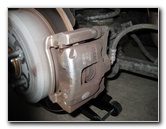 Two 13mm Caliper Bolts |
 Loosen Caliper Bolts |
| Locate the two
bolts on the back of the caliper and loosen them with the 13mm socket and
ratcheting wrench. If the caliper slider pin begins to spin as you try to loosen the caliper bolts, hold it in place with a 17mm spanner wrench or a pair of pliers. |
||
 Caliper Slider Pin Spinning |
 Attach 17mm Wrench or Pliers |
 Remove Upper Caliper Bolt |
| Remove both the upper and lower 13mm caliper bolts and set them aside in a safe place. | ||
 Loosening Lower Bolt |
 Remove Lower Caliper Bolt |
 Pull Off Brake Caliper |
| Once both caliper
bolts have been removed, you can carefully lift the caliper out of the
bracket. Rest the caliper on the rear suspension without placing any stress on the rubber brake fluid line. |
||
|
|
||
 Rest Caliper On Suspension |
 Remove Old Outer Brake Pad |
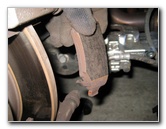 Wear Bar - Bottom Inner Pad |
| Pull the old rear brake
pads out of the caliper bracket and make a mental note of how the wear or
"squeal" bar is situated.
The wear bar on this 2012 Jeep Liberty was located at the bottom of the inner brake pad. I recommend buying the Wagner ThermoQuiet QC1274 since they have excellent reviews on Amazon. Thoroughly clean off the brake rotor, caliper bracket, brake caliper assembly and the lug nut studs with a brake parts cleaner spray. Do not use compressed air or blow air with your mouth to clean off the brake parts since inhaling brake dust can be harmful to your health. Brake dust can be carcinogenic (causes cancer) if inhaled.
|
||
 Check Caliper Slider Pins |
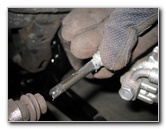 Lubricate & Replace Pins |
 Replace Anti-Rattle Clips |
|
In order for the rear brake caliper to work properly, the two caliper slider pins need to be well lubricated. Pull the upper and lower caliper slider pins out of their rubber dust boots to inspect them. If they appear to be dry, apply a generous amount of a high pressure brake caliper grease. Re-insert the caliper pins back into their dust boots until they snap securely into place. If your new set of rear brake pads came with new metal anti-rattle clips, remove the old ones and install the new ones at the top and bottom of the caliper bracket. |
||
 Attach "F" Clamp |
 Remove Brake Fluid Cap |
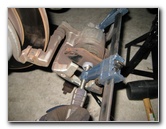 Compress Caliper Piston |
| In order for the
brake caliper to fit over the thicker new brake pads, the caliper piston will need
to be compressed backwards using a "C" or
"F" clamp. Before you begin compressing the piston, move to the engine bay and twist off the brake fluid reservoir cap. Removing the cap will allow the brake fluid to easily travel backwards through the brake lines. Attach the "C" or "F" clamp to the rear caliper piston using the back of an old brake pad to evenly distribute the force across the piston. Repeatedly check the brake fluid level in the reservoir to prevent if from overflowing as you compress the piston. Be sure to replace the brake fluid reservoir cap after compressing the caliper piston since brake fluid is hygroscopic (absorbs water). |
||
 Replace Brake Fluid Cap |
 Install New Brake Pads |
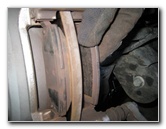 Wear Bar - Bottom Inner Pad |
| Install the new
rear brake pads with the wear bar situated at the bottom of the inner pad. Press the new brake pads flush against the rotor and gently lower the caliper down into the caliper bracket. If the caliper won't fit over the thicker new brake pads, you may need to compress the caliper piston back a bit further. |
||
 Push Pads Against Rotor |
 Lower Caliper Over Pads |
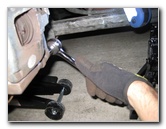 Insert Caliper Bolts |
| Insert the two
caliper bolts and thread them a few turns by hand to prevent them from
becoming cross threaded. Tighten the caliper bolts with the 13mm socket and ratcheting wrench to just past hand tight or about 25 ft lbs of torque. If the caliper slider pin turns as you tighten the caliper bolts, hold it in place with a thin 17mm cone spanner wrench or a pair of pliers. Double check that both the caliper bolts are tight before moving on to the next steps. |
||
 Tighten 13mm Caliper Bolts |
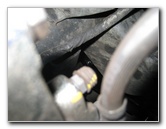 |
 |
| If your brake pedal previously felt soft or
spongy, the brake fluid may be contaminated with water or the brake lines
may contain some air bubbles.
It would be best to bleed the brake lines at this time in order to flush out the old fluid and replace it with fresh DOT3 brake fluid. For more on this topic, check out my Brake Line Fluid Bleeding With An Assistant DIY Guide or alternatively the Brake Line Fluid Bleeding With A Power Bleeder Guide. |
||
 Brake Valve Rubber Cap |
 Brake Line Bleeder Valve |
 Replace Rear Wheel |
| Replace the rear
wheel and spin on the 5 lug nuts by hand to prevent them from becoming cross
threaded. Lower the rear of the vehicle from the jack stands and the floor jack. |
||
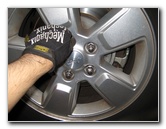 Spin On 5 Lug Nuts |
 Lower Vehicle From Jack |
 Tighten Lug Nuts |
|
Progressively tighten the lug nuts in
a "criss-cross" or star pattern to about 1/4 to 1/2 turn past hand tight. It would be best to use a
torque wrench or an electric
impact wrench with a torque stick to tighten the lug nuts to about 75-100 ft lbs of
torque.
Sit in the driver's seat of the vehicle and pump the brake pedal a few times to restore brake line pressure. Check the brake fluid level in the reservoir and verify that it is at the proper level. If it is low, pour in some fresh DOT 3 fluid. To break in your new rear brake pads, just drive normally for the first several hundred miles while trying to avoid any hard or "panic" stops which may glaze over the new brake pads and cause them to be noisy and/or not perform as well. It's also a good idea to regularly check your driveway for drops of brake fluid which may indicate a leak, check the brake fluid level in the reservoir, and also check that the lug nuts are still tight. For more, check out my other
Jeep Liberty Repair & Maintenance Guides. |
||
| If you found this guide to be helpful,
please consider making a small donation by clicking on the PayPal.com
"Donate" button located to the right of this paragraph. Thank you!
(Note: I am not a registered charity. Donations are not tax deductible.) |

